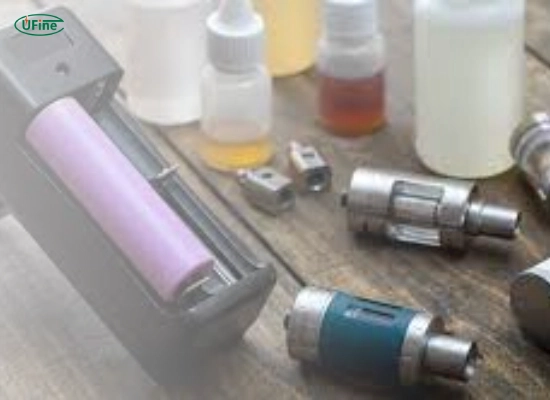In recent years, the popularity of electronic cigarettes, or e-cigs, has skyrocketed. With this surge in usage, understanding the intricacies of e-cig batteries and chargers has become paramount. This comprehensive guide provides everything you need about e-cig batteries and chargers. We’ve covered you, from battery types and safety tips to proper maintenance and troubleshooting.
Part 1. What are E-Cig batteries?
E cigarette battery are the essential power source for your vaping device. They supply the energy to heat the e-liquid, transforming it into vapor. A solid understanding of these batteries is crucial for optimal performance and safety.
What are the different types of e-cig batteries?
E-cig batteries come in various forms, each with unique features and benefits. Let’s dive into the different categories to help you make an informed choice.
Disposable vs. Rechargeable E-Cig Batteries
- Disposable Batteries: Manufacturers design these for single use, typically in primary, entry-level e-cigarettes. Once the battery depletes, users discard the entire device. They offer convenience and simplicity but are less economical and environmentally friendly in the long run.
- Rechargeable Batteries: You can recharge these batteries multiple times using a compatible charger. Rechargeable batteries are more cost-effective and sustainable. They are ideal for regular vapers who want a longer-lasting solution.
Built-in vs. Replaceable Batteries
- Built-in Batteries: Integrated directly into the e-cig device, these batteries are non-removable. Built-in batteries simplify the vaping experience by eliminating the need for separate battery management. However, the device usually needs replacement once the battery’s lifespan ends.
- Replaceable Batteries: You can remove and replace these batteries as needed. Replaceable batteries offer greater flexibility and typically come in standardized sizes, allowing users to carry spares and switch them out quickly. Advanced vapers prefer this type, as it gives them control over their power source.
Popular Battery Types: 18650, 20700, 21700
- 18650: The most commonly used battery in vaping, known for its balance between capacity and power. It offers a reliable performance for both moderate and heavy vapers.
- 20700: Slightly more significant than the 18650, this battery provides a higher capacity, translating to longer vaping sessions before recharging. It’s an excellent option for those who need extended battery life without frequent swaps.
- 21700: The largest of the three, the 21700 battery delivers the highest capacity and power output. It’s perfect for advanced vapers who use high-power devices and require a robust, long-lasting battery.
Part 2. How do you choose the battery for ecig?
Selecting the correct battery for your e-cig depends on several factors, including your vaping habits and the device you’re using. Here are some key considerations:
1. Capacity and mAh Rating
We measure the capacity of a battery in milliampere-hours (mAh)—higher mAh ratings indicate more extended battery life. If you’re a heavy vaper, opt for batteries with higher mAh ratings to avoid frequent recharging.
2. Continuous Discharge Rating (CDR)
The CDR indicates how much current a battery can safely and continuously provide. For sub-ohm vaping, choose batteries with higher CDR ratings to ensure safety and performance.
3. Battery Chemistry
Most e-cig batteries use Lithium-ion (Li-ion) chemistry. Users prefer them for their high energy density and relatively low self-discharge. However, it’s essential to choose reputable brands to avoid safety issues.
Part 3. Safety tips for E-Cig batteries
Battery safety is paramount when using e-cig devices. Here are some crucial tips to ensure you vape safely:
- Use the Right Charger: Always use the charger designed for your battery type. Using the wrong charger can damage the battery and pose safety risks.
- Inspect Batteries Regularly: Check for any signs of damage, such as dents or tears in the wrapping. Please replace the damaged batteries immediately.
- Avoid Extreme Temperatures: Do not expose batteries to extreme heat or cold. Store them in a cool, dry place.
- Do Not Overcharge: Remove the battery from the charger once fully charged to prevent overcharging.
- Use Battery Cases: When carrying spare batteries, use a protective case to prevent accidental short circuits.
Part 4. Understanding E-Cig chargers
Chargers are as crucial as the batteries themselves. They ensure the safe and efficient charging of your batteries. Here’s what you need to know:
Types of E-Cig Chargers
- USB Chargers: Convenient and widely used, these chargers allow you to charge your device through any USB port.
- External Chargers: Users use these chargers for removable batteries, which offer faster charging and often come with multiple slots.
- Passthrough Chargers: Allow you to vape while charging, providing uninterrupted usage.
Features to Look For in a Charger
- Overcharge Protection: Prevents the battery from being overcharged, which can reduce its lifespan.
- Automatic Shut-Off: The charger turns off once it fully charges the battery.
- Multiple Charging Slots: Useful for charging multiple batteries at once.
- LCD Display: Shows the charging status and battery health.
Part 5. How do you properly charge your E-Cig battery?
Proper charging practices can extend the life of your e-cig batteries and ensure safety. Follow these steps for optimal charging:
- Use the Correct Charger: Always use the charger recommended by the manufacturer.
- Charge at Room Temperature: Avoid charging in extreme temperatures.
- Monitor the Charging Process: Check the battery periodically during charging to ensure it doesn’t overheat.
- Unplug When Fully Charged: Remove the battery from the charger once it reaches full charge.
Part 6. Troubleshooting standard battery and charger issues
Even with proper care, you may need help with your e-cig batteries and chargers. Here are some common problems and solutions:
Battery Not Holding Charge
- Possible Causes: Battery age, excessive use, or damage.
- Solutions: Replace the battery if it’s old or damaged. Ensure you are using the correct charger.
Charger Not Working
- Possible Causes: Faulty charger, connection issues, or power supply problems.
- Solutions: Try a different charger or power source. Check for any visible damage to the charger.
Overheating Battery
- Possible Causes: Overcharging, damaged battery, or improper storage.
- Solutions: Stop using the battery immediately. Allow it to cool down and inspect for damage. Replace if necessary.
Part 7. Maintenance tips for E-Cig batteries and chargers
Regular maintenance can prolong the life of your e-cig batteries and chargers. Here are some tips to keep them in top condition:
- Clean Contacts Regularly: Dirt and residue can affect the performance. Clean the contacts with a dry cloth periodically.
- Store Properly: Keep batteries and chargers in a cool, dry place away from direct sunlight.
- Rotate Batteries: If you use multiple batteries, rotate them to ensure even usage and extend their lifespan.
- Follow Manufacturer Guidelines: Always adhere to the manufacturer’s instructions for usage and maintenance.
Part 8. FAQs
-
How long do e-cig batteries typically last?
The lifespan of e-cig batteries varies based on usage, type, and maintenance. On average, a rechargeable e-cig battery can last anywhere from 300 to 500 charge cycles. Proper care can extend their lifespan by avoiding overcharging and exposure to extreme temperatures. -
How should I store my e-cig batteries?
Store your e-cig batteries in a cool, dry place away from direct sunlight and extreme temperatures. Use protective cases to prevent accidental short circuits and physical damage. Avoid storing batteries in pockets or bags where they can come into contact with metal objects. -
What is the best battery for vaping?
The best battery for vaping depends on your device and vaping habits. For most vapers, the 18650 battery is popular due to its balance of capacity and power. For those who need longer battery life, the 20700 or 21700 batteries are excellent options, offering higher capacity and output. -
Are all E-Cig batteries the same?
No, e-cig batteries are not all the same. They vary in size, capacity, chemistry, and performance. The most common types are 18650, 20700, and 21700 batteries, each with advantages. Additionally, some e-cig devices use built-in batteries, while others use replaceable ones.
Related Tags:
More Articles

Top Features of a Good 18650 Battery You Should Know
Learn what makes a good 18650 battery and how to choose the best one for your device. Includes safety tips, top brands, and usage recommendations.
Understanding the Types of NCR18650 Batteries
Explore NCR18650 battery types in-depth. Compare models like B, GA, PF, and BD, and learn their chemistry, specs, uses, and safety features.
Curved Battery Pack vs. Flat Battery Pack: A Comprehensive Comparison for Flexible Electronics
Curved battery packs vs flat: compare flexibility, use cases, and performance to choose the right power source for modern electronic devices.
Where to Buy 3.7 V Lithium Ion Battery 850mAh Nearby?
Where to buy a 3.7 V lithium-ion battery 850mAh nearby? Learn specs, how to choose the right one, and where to buy it fast from nearby or direct from makers.
CR123A 3.0 V Lithium Battery vs 16340 Battery: Difference explained
CR123A and 16340 batteries look alike but differ in voltage, safety, and use. Learn the key differences to choose the right one for your device.





